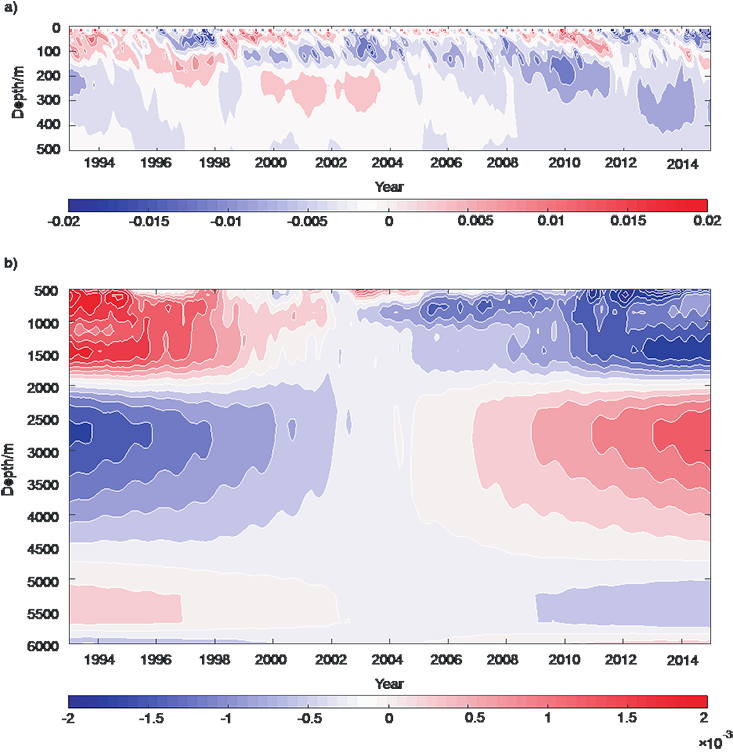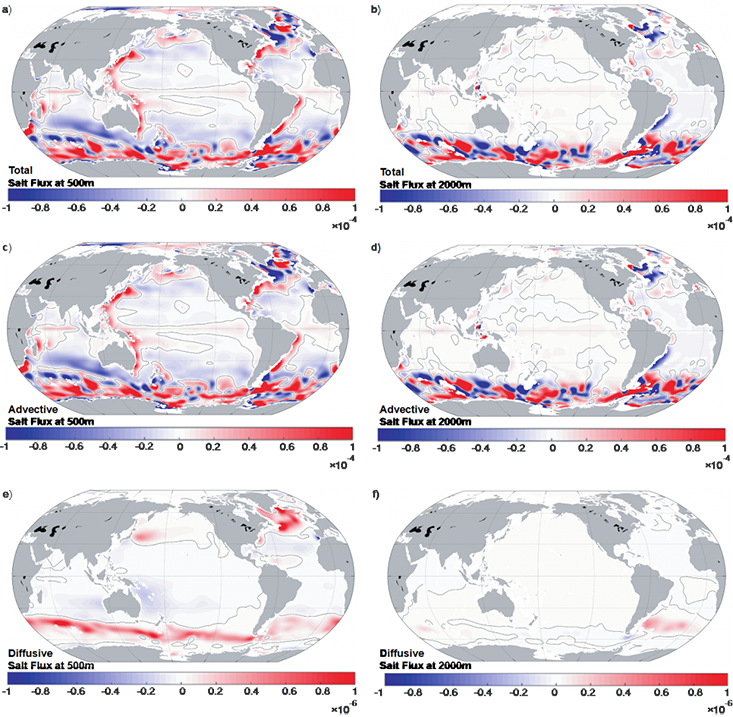Written by Sean Beckwith, Web Content Developer for USF CMS
ST. PETERSBURG, FL – The ocean is, on average, greater than 3500 meters deep (11,500 feet). Scientists sample the ocean from ships, space-based satellites, oceanographic buoys tethered to the seafloor, and from a promising array of autonomous vehicles. But how deep is deep enough to infer changes in earth’s climate system based on those observations?
Researchers at the USF College of Marine Science (CMS), along with colleagues from Atmospheric and Environmental Research (AER), NASA Headquarters, Cambridge Climate Institute, and NASA’s Jet Propulsion Laboratory, recently published a paper in Nature Communications emphasizing the importance of the deep ocean’s contributions to the upper ocean.
“We essentially did a budget analysis of the global ocean salinity from the surface to the bottom of the ocean,” says Chao Liu, lead author on the paper and recent graduate of CMS. “Most of the ocean measurements are focused on the top few hundred meters of the ocean where most of the variability happens, but changes in the deep ocean are also very important.”
Using a state-of-the-art ocean synthesis product, Estimating the Circulation and Climate of the Ocean (ECCO), Liu, his advising professor Xinfeng Liang, and coauthors Rui Ponte, Nadya Vinogradova, and Ou Wang found changes in the globally-averaged ocean salinity over a 22-year time period that differ depending on the depth layer.

This time evolution of the globally-averaged ocean salinity highlights the point that salinity variation by depth is important to capture when inferring global change from ocean measurements.
Climate Implications
As an example of the implications of the team’s findings, imagine that the salinity of surface ocean were used as a sort of “rain gauge” to infer changes in the water cycle (evaporation and precipitation) as well as any freshening of the ocean that might be attributed to melting ice sheets and glaciers. If the upper ocean were experiencing a net upward movement of salt over the same time period as melting ice was adding freshwater to the surface ocean, then a simple direct measurement of the surface layer (the upper 200 meters) would actually underestimate the freshwater influx by not considering the addition of saltier water from the deeper ocean.
Liang and colleagues are hesitant to throw much weight behind one particular number, due to uncertainties in the data, but 700 meters seems to be a reasonable choice. Based on the results of the ECCO data, the vertical salt flux is zero at around 700 meters, meaning that all of the salinity changes above that depth should be due to the freshwater input.
The Ocean Synthesis Product
“ECCO is configured with everything we know about the ocean (data, dynamics, etc.), and with this data constrained estimate, we are able to see the changes below the upper ocean and further know where they come from,” explains Liu.
Liang adds, “When people talk about ocean changes—temperature, salinity, that kind of thing—the most direct way to look at that is the observations. And if you look at the amount of observations available, most are in the upper ocean. And for the past 15 years, that’s mainly due to the Argo float program; it’s dramatically increased the available number of ocean measurements.”
Motivated by Liang’s previous work on the vertical redistribution of heat inside the ocean, the new study on salt focuses on a similar time period (1993–2014) to see how much of the changes observed in the upper ocean is due to two types of factors: (1) something happening at the surface and translating to the deeper ocean, and (2) something going on inside the ocean.

These images show the spatial distribution of the vertical salt flux in the global ocean. In all panels, positive values stand for upward salt transport with the ocean depicted at a depth of 500 meters in the left series and at a depth of 2000 meters in the right series. The influence of the Southern Ocean is strongly apparent.
By comparing the contributions of external forcings on the upper ocean with the internal
dynamics, Liang and colleagues are able to gain a more complete picture of changes
occurring in the ocean.
What they found is a freshening trend in the surface ocean, then a layer of salinification, and at even greater depths, a slight freshening again. The magnitude of the changes seems to match that of the internal ocean flux (the exchange between the upper and deep ocean), which has led the researchers to conclude that the internal contribution is a major reason for the layered salinity structure. It also means that the internal variability is a major factor to consider when quantifying atmospheric–oceanic interactions.
The paper shows that the internal flux of salinity (vertically) can be as large as external fluxes caused by freshwater contribution or, likewise, by salinification (for example, the formation of sea ice, which removes freshwater while adding salt to the ocean).
Next Steps for the Research Community
Making direct observations of the water column from top to bottom over a significantly large representation of the global ocean is not yet possible. Using models like ECCO, though, scientists are working with the best available synthesis of the data to understand how the ocean moves and how water properties change spatially and temporally.
This study offers fundamental information for the physical oceanographic community to consider as well as the biogeochemical community. The distribution of the vertical salt flux implies vertical velocity in the Southern Ocean plays an essential role in the vertical exchange of ocean properties and materials. Recently, studies of iron in the Southern Ocean have found that iron released by hydrothermal vents quickly makes its way to the surface, which is directly in line with the estimates of vertical flux calculated by Liang’s group.
Better understanding of the movement of biogeochemical tracers, and the vertical exchange of materials essential to life, such as iron and other nutrients, will improve scientists’ understanding of carbon cycling and other key processes in the ocean.
Corresponding author, Xinfeng Liang, has recently accepted a position at the University of Delaware.
